
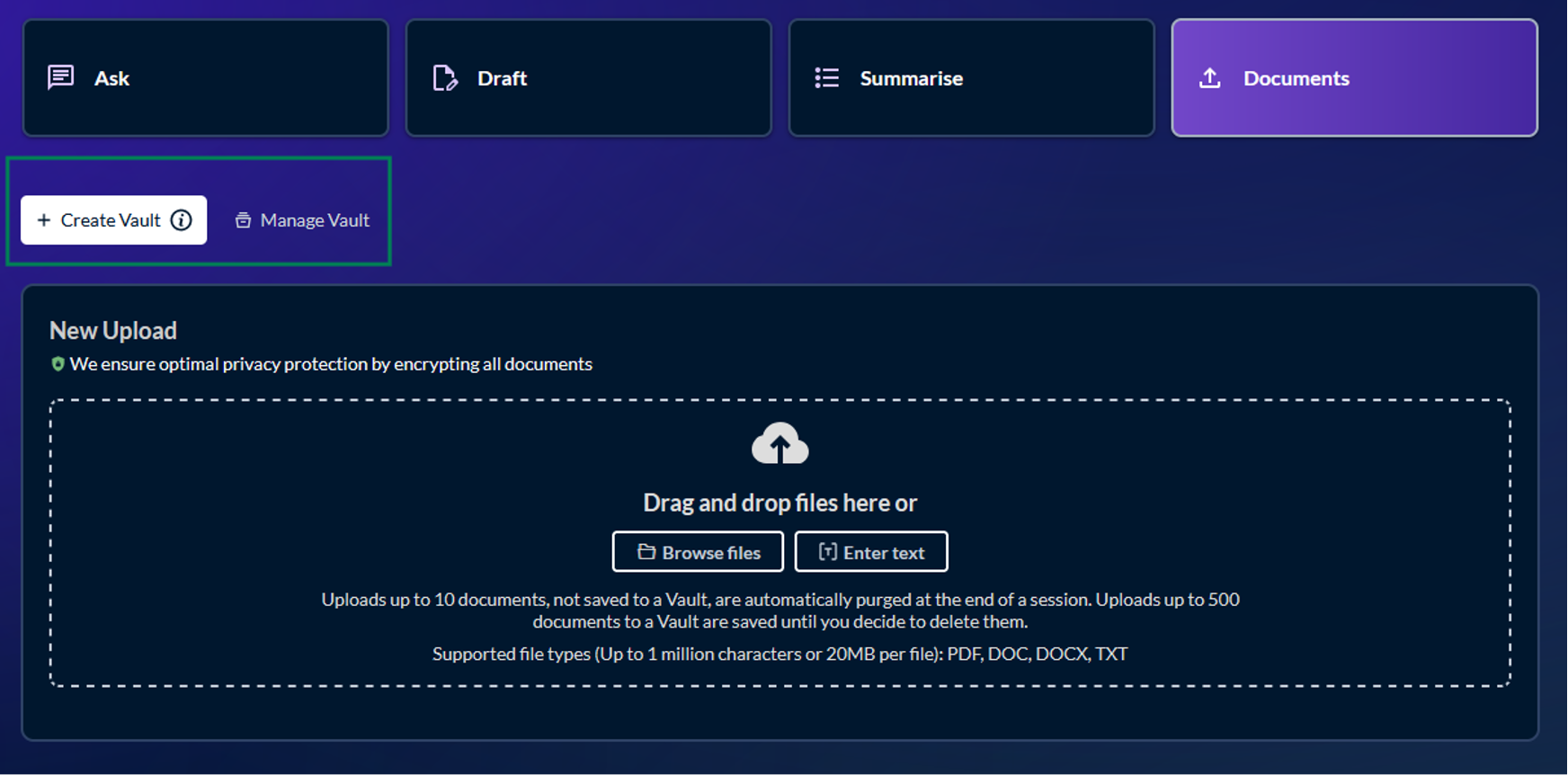
- Upload First: Upload your documents, then choose whether to create a Vault, or use the documents on a one-time basis. Note that a one-time upload is limited to 10 documents. If you upload more than 10 documents, you will be prompted to create a Vault.
- Create First: Set up a Vault first, then decide later which documents to include in your Vault.
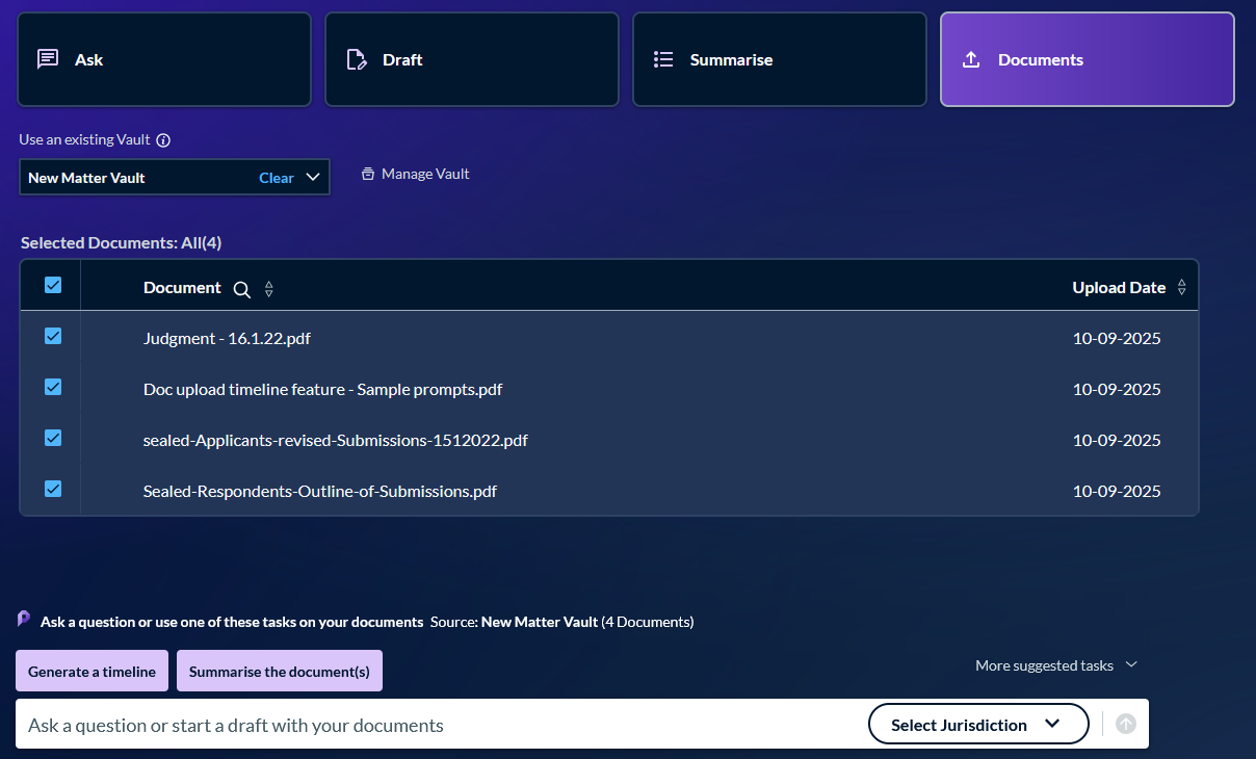
- Generating Timelines: Automatically create detailed timelines.
- Drafting Documents and Correspondence: Efficiently produce full transactional documents, clauses, correspondence, and legal memos, grounded in the documents in your Vault and LexisNexis® content.
- Summarising Documents: Quickly obtain concise and accurate summaries.
- Extracting Arguments: Identify and extract key arguments in seconds.
- Comparing Documents: Contrast and analyse multiple documents side-by-side.
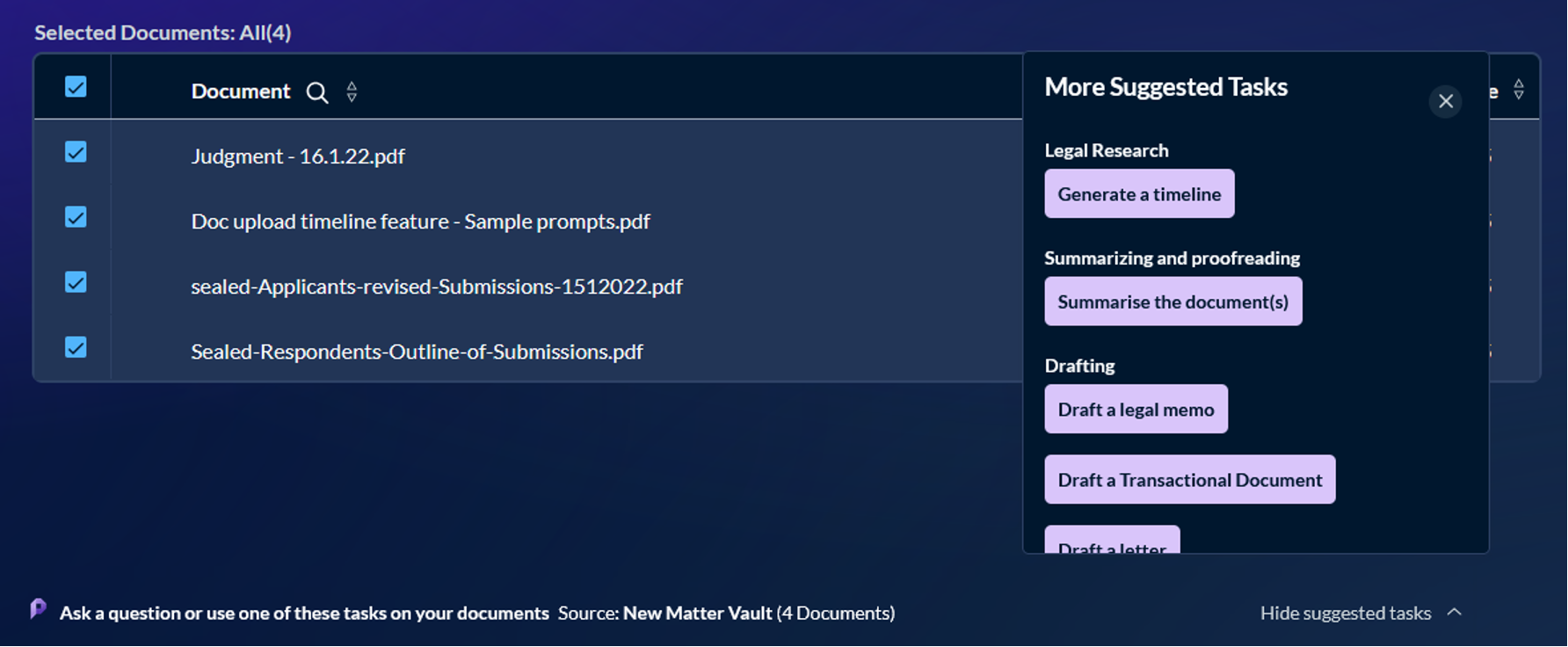
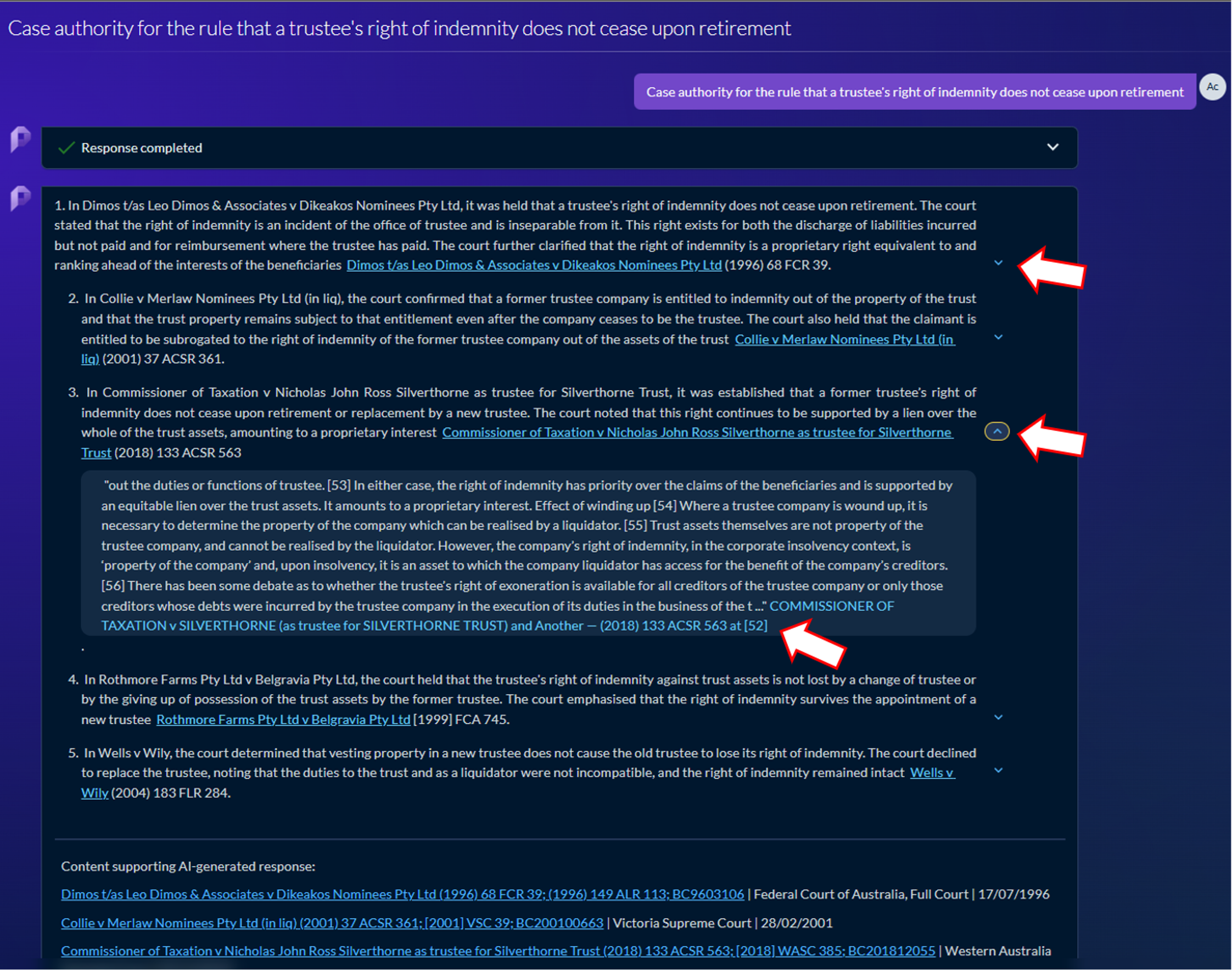
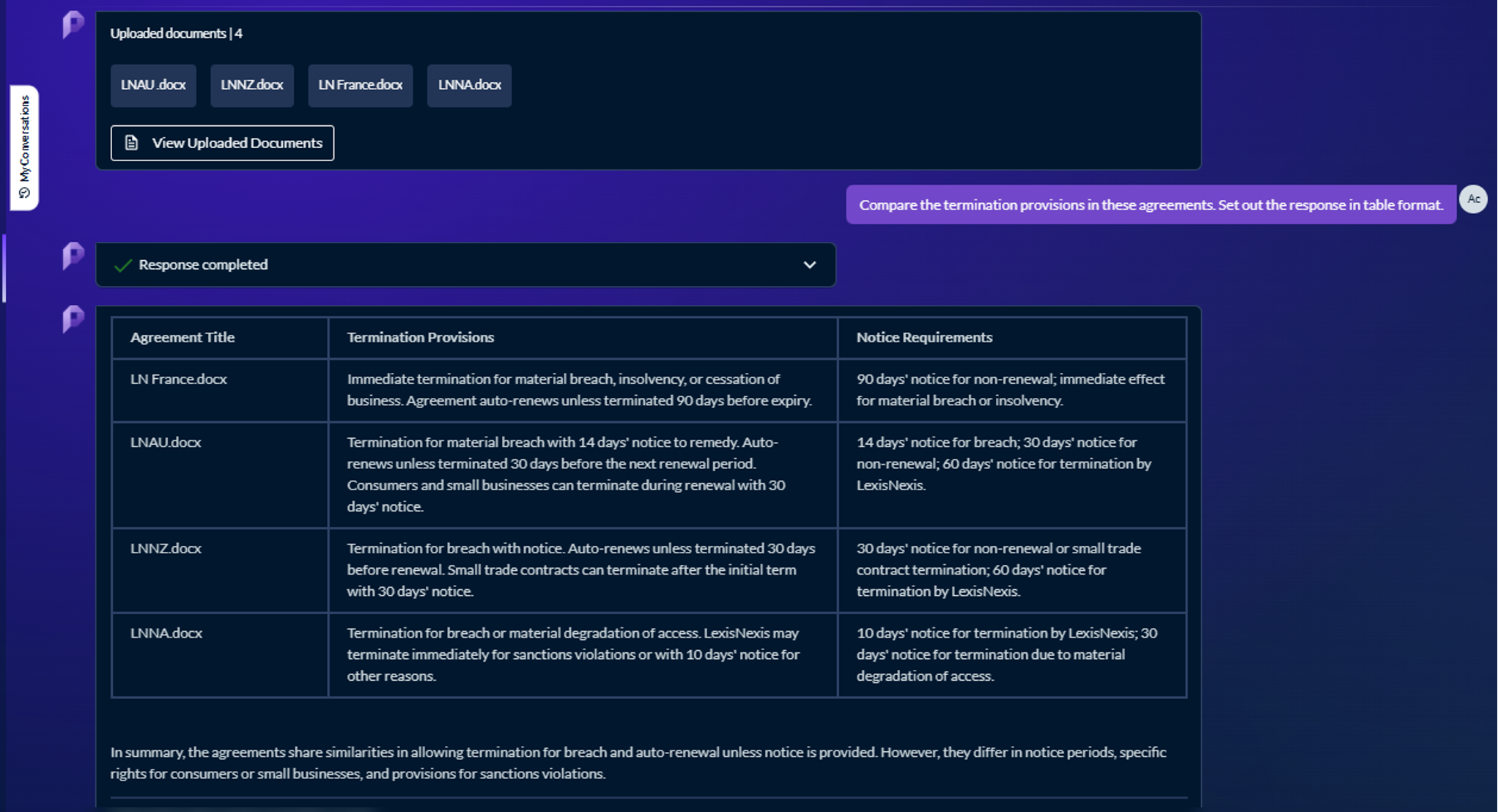
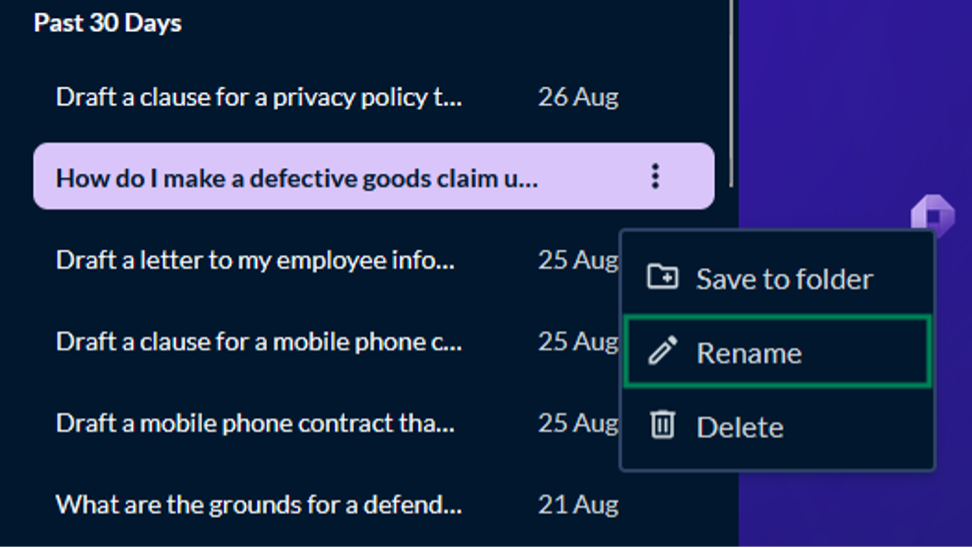





ASIC has signaled its commitment to pursuing cryptocurrency regulation in the courts by lodging an application for special leave to appeal to the High Court following the victory of Block Earner in ASIC v Web3 Ventures Pty Ltd [2025] FCAFC 58. The case has become a testing ground for how Australia’s regulatory framework is adapting to rapid technological change in digital assets and fintech product markets.
If it reaches the High Court, this case may have the potential to become a leading precedent on digital asset regulation in Australia. Accordingly, our Financial Services Newsletter panel members have been tracking the case’s development since its inception. FinTech expert, Andrea Beatty, and her team at Piper Alderman have provided an update on the appeal in Issue 24(5), “High stake in the High Court: why the Block Earner case matters”. Customers will benefit from its succinct, well-considered explanation of the background and context of the case, as well as expert analysis on the significance of its movement toward the High Court.
The Federal Circuit and Family Court of Australia (Division 2) (General Federal Law) Rules 2021 have been replaced by the Federal Circuit and Family Court of Australia (Division 2) (General Federal Law) Rules 2025. These new rules were registered on 11 August 2025 and will commence on 1 September 2025. The new Rules were created to ensure greater consistency for practitioners and registrars and jurisprudential certainty in resolving procedural matters. Practitioners will need to be aware of the new Rules and how they apply.
John Mathieson and former Federal Circuit Court Judge Rolf Driver, two of our expert authors for High Court Federal Court Practice and Procedure, are underway with the task of transferring relevant commentary from the 2021 Rules to the 2025 Rules, to ensure that the new Rules are ready with annotations to assist subscribers with applicable case law, as soon as possible after commencement.
The Supreme Court (General Civil Procedure) Rules 2015 were originally made on 10 September 2015 and came into operation on 23 November 2015. Under the Subordinate Legislation Act 1994, these rules are set to sunset all at once exactly 10 years after their making, which means they expire on 10 September 2025. As of now, no replacement has been published or entered into force. The current 2015 Rules remain operative beyond that date unless a remake occurs prior to expiry. A remake is expected within a week of 28 August 2025.
The Supreme Court (General Civil Procedure) Rules 2015 are scheduled to sunset on 10 September 2025 under the Subordinate Legislation Act 1994. While no replacement instrument has yet been published, we expect it will be published soon. Our authors, David Bailey, Daniel Nguyen, and Nicolas Dour, are closely monitoring developments and will update Civil Procedure Victoria promptly once the new rules are made.
Over the last few years, there has been a lengthy string of cases being brought before the NSW Court system regarding the financial services company, Keybridge Capital Ltd. There have been numerous appeals against the decisions, dating back to 2021. This litigation continues on, with the most recent decision being handed down on 30 July 2025. The case pertains to the validity of shareholder notices to remove and appoint directors, and the decision to move shareholder meetings online due to COVID-19 safety regulations.
The impact of these cases has been discussed in earlier editions of Butterworths® Corporation Law Bulletin, but the most recent was discussed in the July edition (2025.5). In a case note, the most recent was analysed and acts as a timely reminder for all companies and their chairpersons that they should consider the wording of the company's constitution to ensure that the wording around meeting adjournments is not ambiguous. This string of litigation touches on some of the most vital aspects of running a company (shareholder meetings and the company constitution) and the case notes and articles discussing Keybridge in this newsletter serve as important discussions, in easy to digest formats, that all users will benefit from.
In NSW, sexual assault is considered to be aggravated if “the complainant is … under the authority of the accused person”: Crimes Act 1900 s 61J(1)(e). The meaning of “under the authority of” in this provision was considered in Hu v R [2025] NSWCCA 66 in the context of an osteopath convicted of offences against female patients, with the court holding that where there is a relationship of patient and health care professional, and the patient is receiving treatment, the patient is “in the care of” and therefore “under the authority of” the health care professional.
This case is of particular significance because usually the phrase “under the authority of” is used in cases against step-parents, parents, teachers, etc, of complainants under the age of 18, or where complainants have an intellectual disability. There have been a small number of trials in lower courts holding that the phrase applied regarding medical professionals in relation to adult complainants of normal cognitive ability, but it is only now, in Hu v R, that the NSW Court of Criminal Appeal has affirmed that this approach is correct. Customers are kept up to date with this important development, as this case is discussed by Peter Johnson SC (Commissioner of the NSW Law Enforcement Conduct Commission) in his recent annotations in Criminal Practice and Procedure NSWt at [8-s 61J.5], and a casenote on the case is featured in Issue 7 of Criminal Law News at [5044] – written by Justice Hulme of the NSW Supreme Court.
The NT has implemented Stage 1 and Stage 2 of the Model Defamation Reforms through the Defamation Legislation Amendment Act 2025, commencing on 11 August 2025. Tasmania has also implemented Stage 2 reforms through the Defamation Amendment Act 2025, commencing on 16 June 2025.
Michael Sexton SC is currently updating the notes and commentary in Australian Defamation Law and Practice to reflect the adoption of the uniform defamation provisions in the NT and Tasmania. Uniform amendments pertaining to the serious harm defence, the addition of a further category of publication entitled to absolute privilege, and digital intermediary liability are all helpfully canvassed in the Defences in Defamation, Absolute Privilege and Honest Opinion in Defamation, and Internet and Social Media chapters, respectively, so that NT and Tas customers can be prepared for these changes to defamation laws in their jurisdiction.
Davis Stack Capital Pty Ltd v RAJ & JAI (Mudgee) Pty Ltd [2025] NSWSC 791 was a case handed down by the Supreme Court of NSW on 13 June 2025. Primarily a contractual case, it concerns a $70 million sale of units in a trust where the sole asset was a land development in Mudgee. Specific performance was sought by the sellers due to breach of the Unit Sale and Purchase Agreement by the buyer and its parent company (as guarantor). This case has clarified the limits of guarantor liability in complex commercial sale agreements, as well as underscoring important points for insurers and commercial drafters, including that Guarantee construction is strictissimi juris and specific performance is still the default/main remedy for land/land-like assets.
Authors Peter Yeldham and Darcy Jackman, in an article for the Australian Dispute Resolution Bulletin, discuss in detail the decision’s reinforcement with orthodox contract principles: strict limits on guarantor liability, commercial construction, and the routine grant of specific performance, and the practical implications of drafting indemnities and guarantees in high-value transactions.
A recent High Court decision was handed down in Helensburgh Coal v Bartley [2025] HCA 29, where the HCA ruled that an employee’s dismissal was not a “genuine redundancy” under s 389 of the Fair Work Act 2009 (Cth). The HCA found that the employer failed to consider redeploying the employee into roles performed by contractors, which could have been reasonably offered through internal restructuring. Section 389 defines a "genuine redundancy" partly by whether it was reasonable to redeploy the employee within the business. The HCA clarified that “reasonable” includes replacing contractors with redeployed employees, if doing so “would not fundamentally alter the business”. This interpretation broadens the scope of employer obligations and limits the ability to rely on redundancy as a lawful dismissal ground.
Michael Byrnes, Partner at Swaab and a long-term author of Workplace Law – Fair Work, has recently updated annotations to the Fair Work Act Part 3-2, on Unfair Dismissal, including a discussion of this case. The decision is significant because it broadens the scope of what constitutes a “genuine redundancy,” raising the bar for employers. This update is a fantastic guide for subscribers who must now consider redeployment options beyond existing vacancies, including restructuring contractor roles, and bear that in mind when undertaking company restructuring and reassessing redundancy policies.
Following developments introduced by the Family Law Amendment (Information Sharing) Act 2023 (Cth), the Family Law Amendment Act 2024 and the Federal Circuit and Family court of Australia (Family Law) Amendment (2025 Measures No.1) Rules 2025 (Cth), several changes have come into effect to ensure the protection of vulnerable parties and other persons, such as children, from disclosure of information that could be harmful to them.
As a result of these changes, our expert family law author Michelle Daniel is currently updating four separate Family Law precedent suites located in the Australian Encyclopaedia of Forms and Precedents. These guidecards include: Family (Child Support), Family (Divorce), Family (Appeals, Subpoenas and Correspondence), and Family (Superannuation). Michelle has re-written with great detail many of the introductory notes which inform users of the current state of the law, as well as updated the precedents to reflect current practice. Subscribers will soon have up-to-date precedents with detailed introductory notes ready for use in family practice.
In the recent decision of Shinohara & Shinohara [2025] FedCFamC1A 126, the Appeal Division of the Federal Circuit and Family Court of Australia (Division 1) decisively indicated that notional property (or add-backs) are no longer items to be included in the balance sheet. The court has confirmed that the entrenched family law practice of notionally adding back property that no longer exists to the asset pool is a thing of the past. This is an important decision as it is the first time the full court has interpreted the recent changes to s 79 of the Family Law Act introduced by the Family Law Amendment Act 2024 in June 2025.
Martha Barnett SC has recently updated the annotations to section 79 of the Family Law Act in Australian Family Law to include a discussion of the decision of the Full Court in Shinohara & Shinohara. Along with fellow authors Richard Chisholm, retired Family Court Judge, and Julie Suthers, Federal Circuit and Family Court of Australia Judge, she is also currently updating the Family Law Act commentary in light of the recent significant changes made by the Family Law Amendment Act 2024.
The High Court has recently granted special leave to appeal to Bed Bath 'N' Table for its ongoing litigation with Global Retail Brands Australia. The Bed Bath 'N' Table v Global Retail Brands Australia Pty Ltd case has been integral in bringing about discussion in the trade mark area around the role and importance of reputation acquired through trading under a unique brand name, the ability to rely on said reputation in making consumer law and passing off claims, regardless of whether trade mark infringement is able to be established, as well as what circumstances the 'fitted for purpose test' applies in assessing a consumer law and/or passing off claim. The case also raised interesting issues surrounding evidence, such as the role of evidence and distinguishing evidence in surrounding circumstances, such as deceptive similarity, from evidence of reputation.
Natasha Burns, Sophie Clapin, and Deborah Jackson from Allens have written a thought-provoking and in-depth article on the case for an upcoming issue of the Intellectual Property Law Bulletin. The article explores the first instance and appeal decisions, as well as the reasoning put forward by both parties in the High Court special leave appeal. The article provides an in-depth background of each stage of the case, as well as a detailed discussion sounding the multiple interesting issues that have arisen in the dispute and what this means for trademark owners. The article will help practitioners and brand owners to further understand the rights you obtain from trademark registration and the rights you obtain from reputational rights, as well as the importance of growing reputation in sub-brands or truncated versions of key marks. The issue containing the article is set to be published in late September/early October.
The Privacy Act 1988 (Cth) has been amended to introduce a new statutory tort for serious invasions of privacy, which now appears in Schedule 2 of the Act. While the statutory tort was enacted in the Act by the Privacy and Other Legislation Amendment Act 2024 (Cth), it is a standalone cause of action to be read and construed separately from the rest of the Privacy Act. This new statutory tort came into force on 11 June 2025. The new tort is intended to provide a flexible, uniform framework to address current and emerging privacy risks, to provide individuals with a cause of action that addresses a broader range of serious invasions of privacy, including interference with an individual’s seclusion as well as the misuse of information relating to that individual.
Expert author, Jane Rawlings, has written new commentary within the "Laws of confidence and misuse of private information" chapter in the Privacy, Confidentiality and Data Security publication to comprehensively explore the new statutory tort of serious invasions of privacy. Rawlings not only outlines the key elements of the tort that an individual would need to prove, but also comprehensively explores each element, providing customers with an in-depth understanding of the tort while exploring supporting case law. Rawlings goes further to discuss defences, remedies and exceptions to the statutory tort.
On 1 August 2025, the new Property Law Act 2023 (QLD) came into force. One focus of its new provisions is on the new seller disclosure regime for property transactions. Its objectives are to clarify the disclosure obligations of sellers, introduce a transparent and effective form of disclosure, provide information of value to the decision of a buyer to purchase, and to balance the information cost between buyer and seller. These provisions are also accompanied by a new version of the REIQ contract for the sale of land.
Australian Property Law Bulletin General Editor, Professor Sharon Christensen, has written an informative article in that publication setting out the primary new obligations on sellers when giving disclosure statements to potential purchasers under the new regime. It sets out what transactions require a seller disclosure statement, what the exceptions are, when the documents should be given, and what information they should contain. Legal practitioners should ensure that they are up to date with these changes, as parties and agents are also dealing with the widespread differences from how they used to operate.

- Private Investment Law, available now
- Interpretation of Testamentary Documents, 2nd edition, available now
- Bribery, Corruption and Sanctions Laws in Australia, available now
- The Loan Book, 2nd edition, available now
- QRC Administrative Law, 5th edition, available now
- Australian Migration Legislation Collection, June 2025, available now
- QRC Immigration Law, 2nd edition, available now
- Focus Land Law, 6th edition, available now
- QRC Criminal Law for Common Law States, 3rd edition, available now
- Civil Procedure Commentary and Materials, 9th edition, available now
- Carter’s Criminal Law of Queensland, 27th edition, available December 2025
- Annotated Conveyancing and Real Property Legislation New South Wales, 2025-2026, available November 2025
- Annotated Criminal Legislation in New South Wales, 2025-2026, available November 2025
- Austin and Black, Australian Corporations Legislation, 2026, available December 2026
- Powers of Attorney, 4th edition, available December 2025
- Annotated Personal Property Securities Law in Australia, 5th edition, available September
- Essential Guide to Mortgage law In Australia, 3rd edition, available September

- Bribery, Corruption and Sanctions Laws in Australia
- Private Investment Law
- Hutley's Australian Wills Precedents, 11th edition
- Domestic and Family Violence Law in Australia
- Annotated Civil Liability Legislation — Queensland, 6th edition
- Law of Code: Blockchain and the Law in Australia
- Estate Planning: A Practical Guide, 6th edition
- Constitutional Law in Australia, 5th edition
- The Loan Book, 2nd edition
- Australian Trade Mark Practice: Selecting, Registering and Managing Trade Marks
- Personal Injury Claims: Investigation and Preparation from Inception to Trial, 2nd edition
- The Law of Liability Insurance, 4th edition
- Sexual Assault Trials: Challenges and Innovations

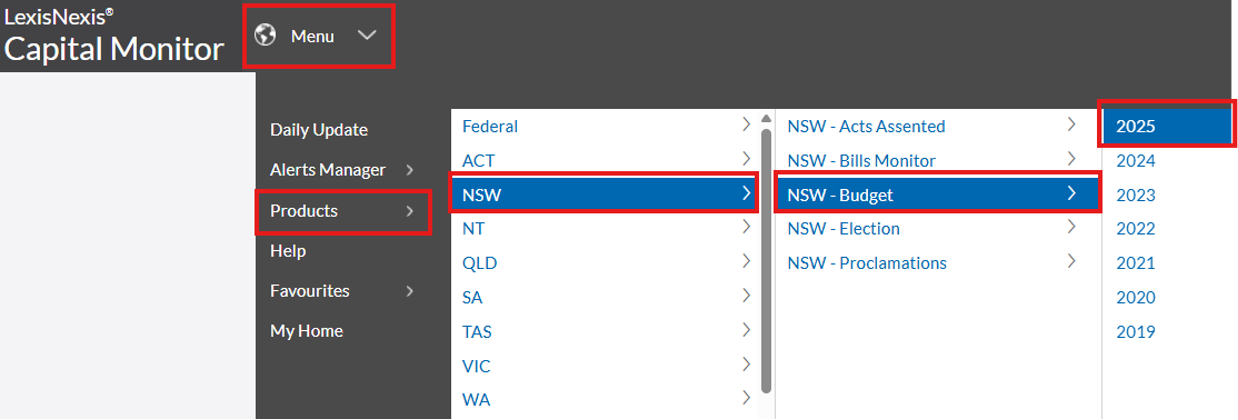
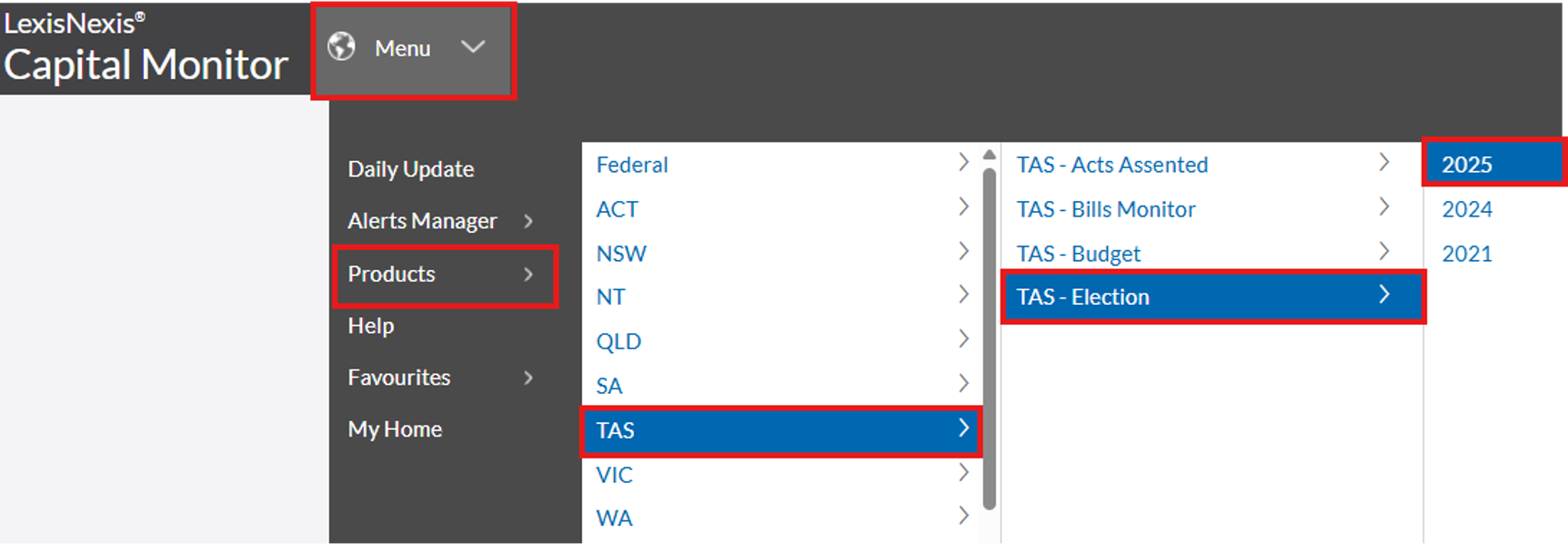
- Go to: Menu > Alerts Manager > All Options > Personal Alerts
- Enter Alert Name
- Select Search Collection
- Enter search term(s)
- Select Delivery Type
- Click Save
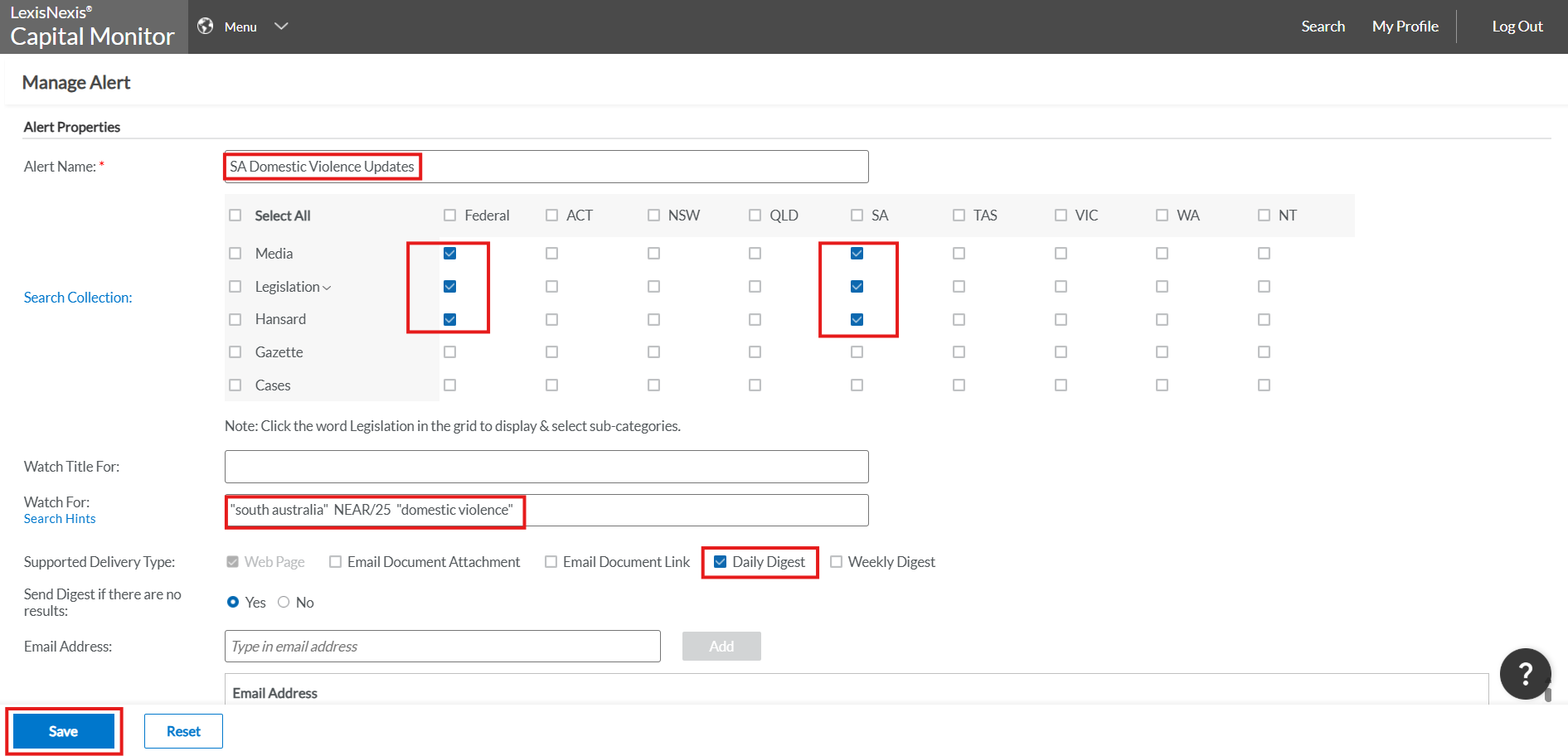
- Go to: Parliamentary Research
- Enter search term(s)
- Select Parliamentary Resources
- Click Search
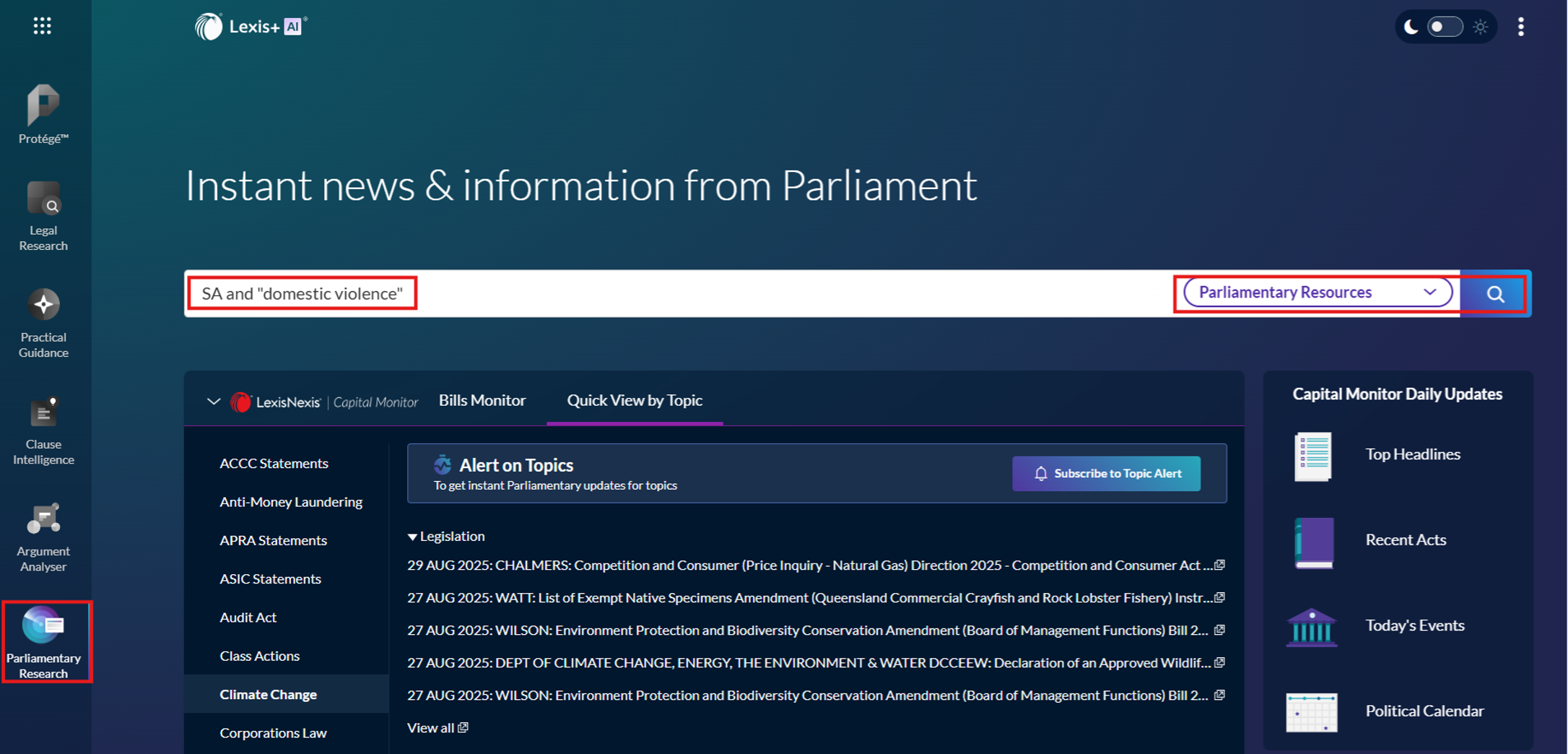
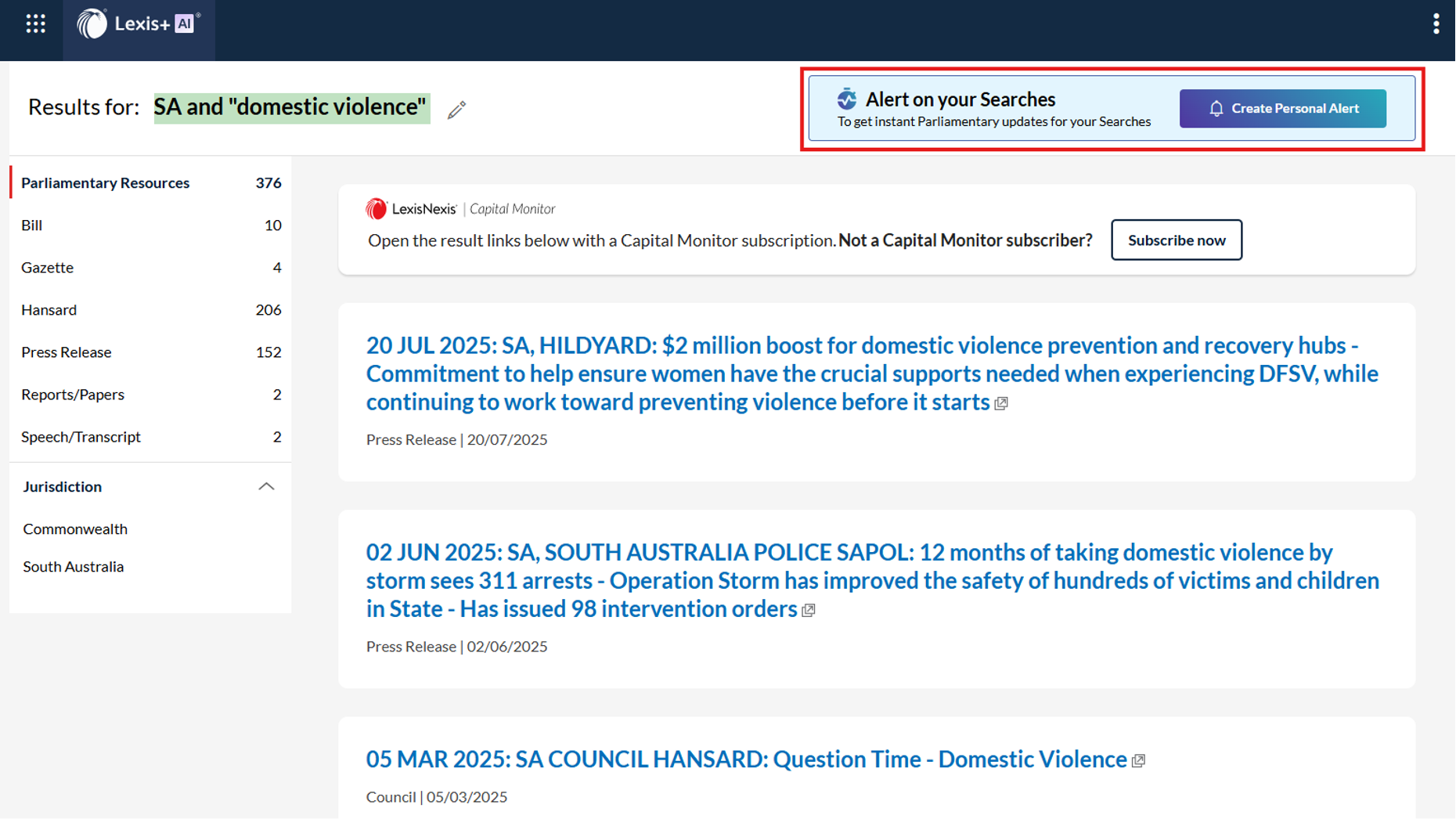

- Protégé is the legal generative AI assistant that works alongside you to deliver brilliant, personalised drafts. You can Ask, Draft, and Summarise directly in your Word document.
- Easily identify trusted clauses and client-specific language to draft new agreements or contracts quickly, from your secure library, so you can maintain your firm’s unique style.
- Generate new clauses and language while being assisted by the powerful generative AI and authoritative content from your LexisNexis subscription.
- Check for errors, omissions, and inconsistencies with tools that proofread, cross-reference, ensure number consistency, dollar amounts, and find legacy language and inclusive language.
- Polish, perfect, and secure your documents, scrub metadata, redact, and convert to PDF.
- Finalise your document, then send, sign, and track your agreements using the DocuSign integration.


- Open Lexis+ or Lexis Advance and enter text within the search field
- Select AU News from the content drop-down
- Click Search
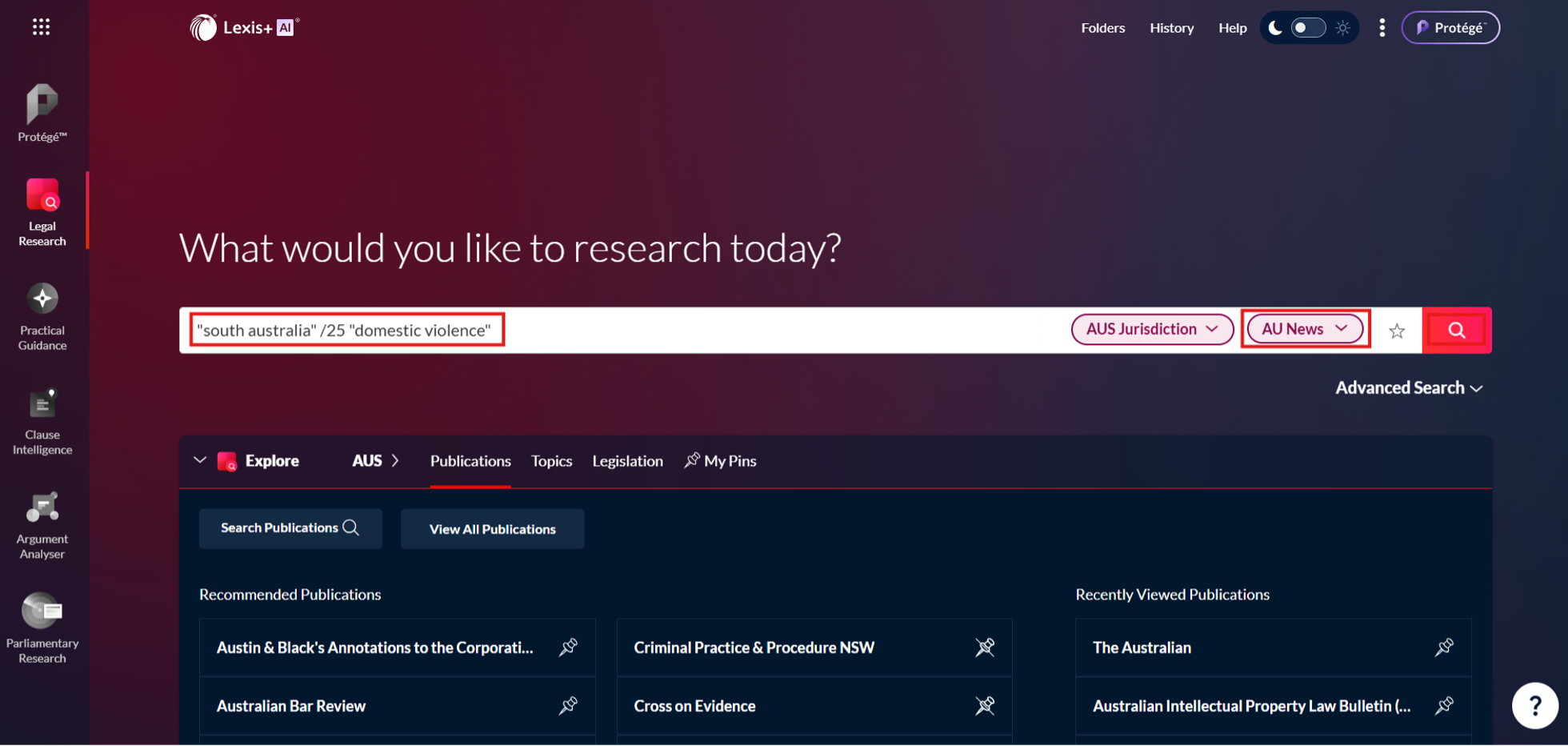
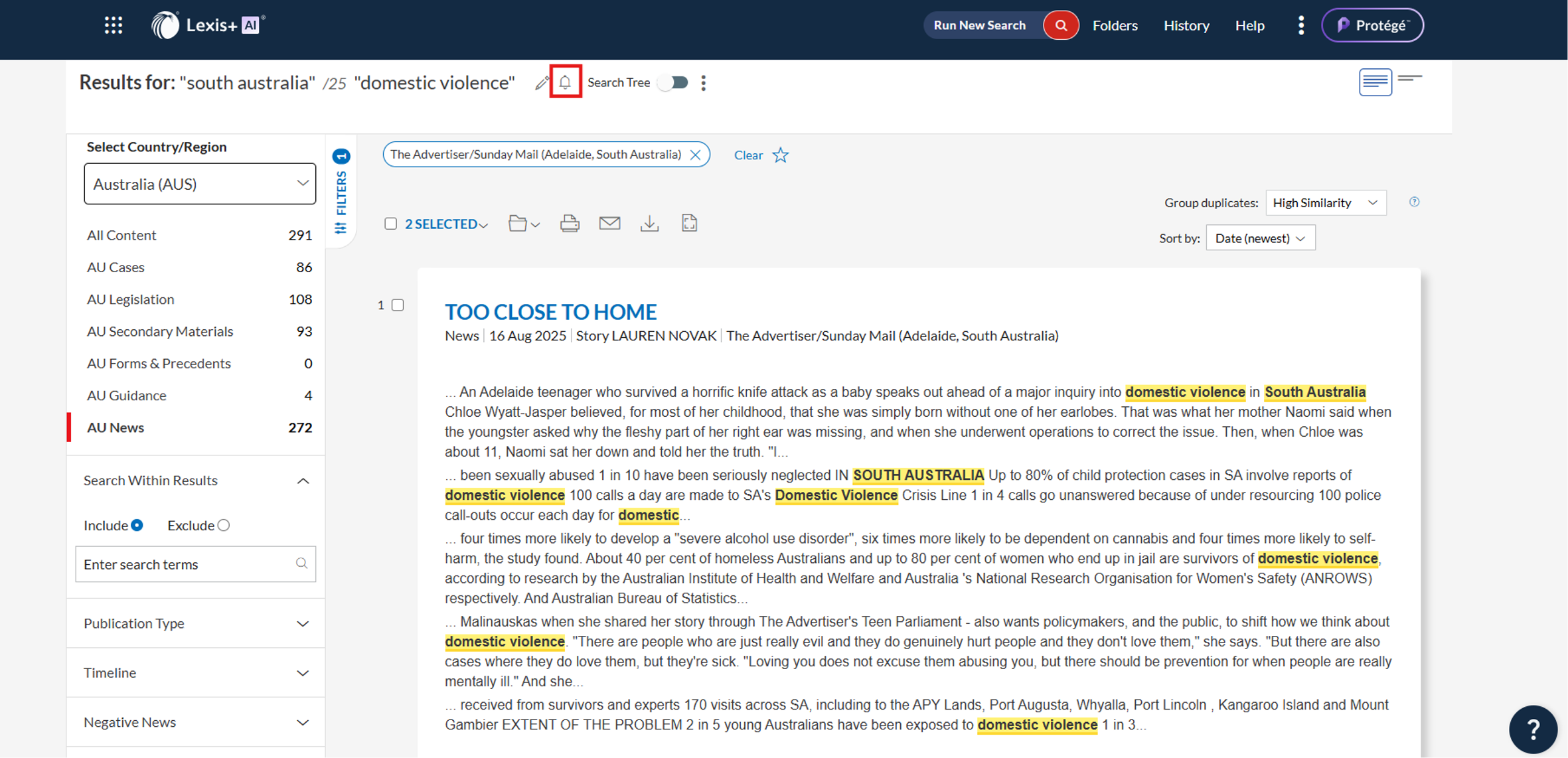

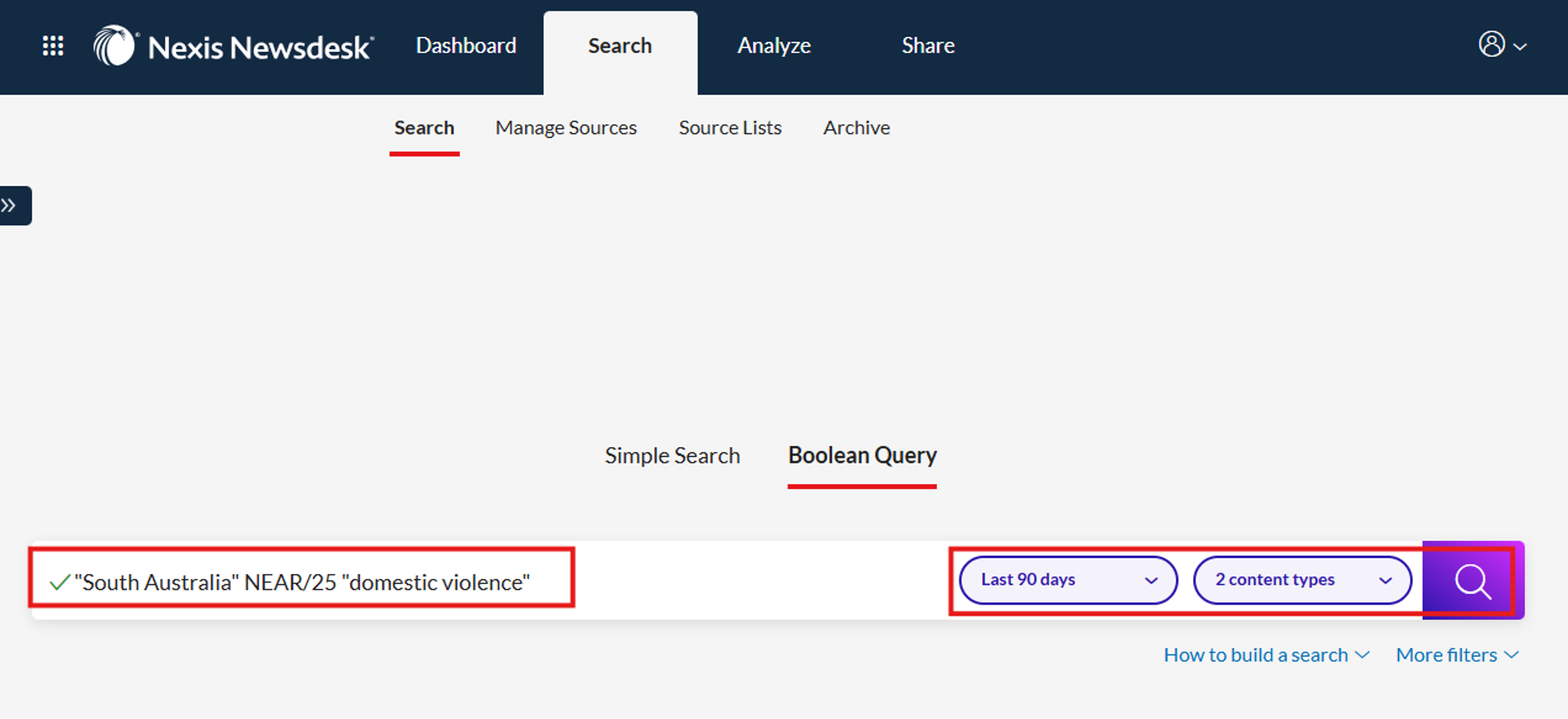
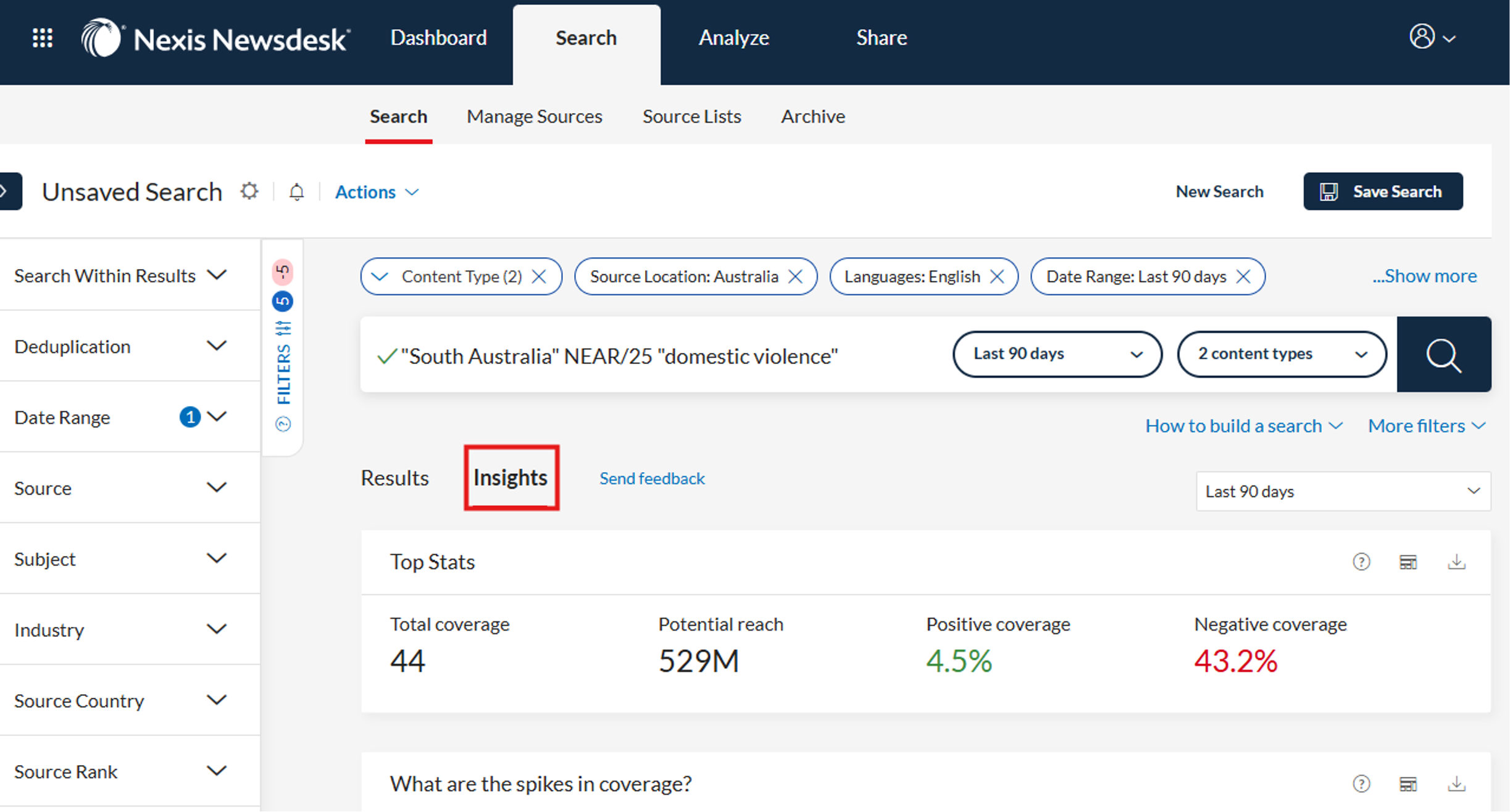
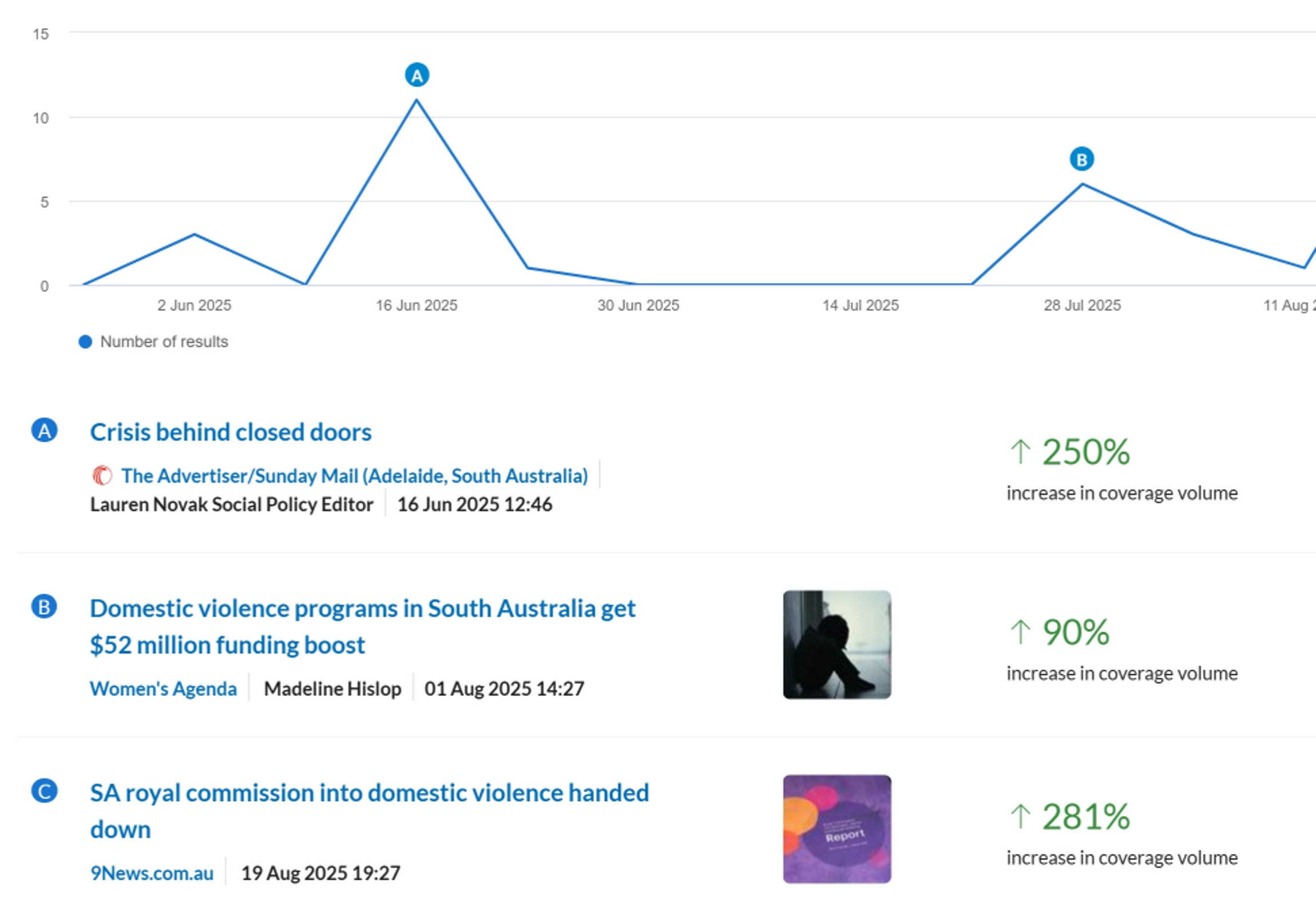
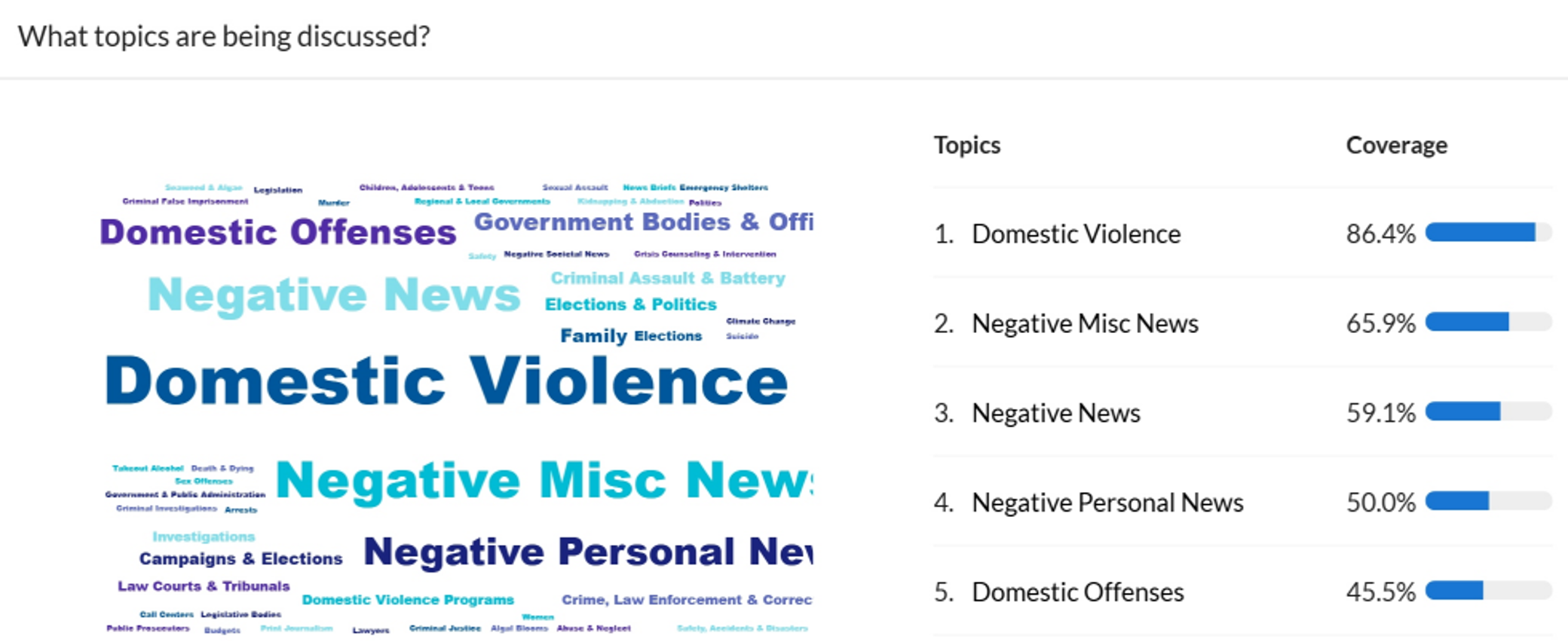

New | Topic: Debt Capital Markets
Our new topic will assist those advising Australian issuers, arrangers, and dealers on debt capital markets transactions. The topic provides comprehensive guidance on:
- the types of debt securities (including zero coupon securities) prevalent in the Australian wholesale market
- key provisions in debt capital market transactions in Australia, with some comparison to market practice for international issuances
- documenting an Australian medium-term note (AMTN) programme (including a comprehensive drafting guide for AMTN terms and conditions)
- the steps for establishing and issuing notes under an AMTN programme, and
- listing debt securities on the Australian Securities Exchange (ASX).

Coming Soon | New Guidance: ESG Risks in Commercial Contracts
New guidance note in the Commercial contracts – contract lifecycle topic that discusses environmental, social, and governance factors when drafting and reviewing commercial contracts.
Coming Soon | New Guidance: Insurance in Commercial Contracts and Transactions
New guidance note in the Commercial contracts – contract lifecycle topic that discusses the critical role of insurance in commercial contracts and transactions.
Coming Soon | New Guidance: Enforceability of Commercial Contracts
New guidance note in the Commercial contracts – contract lifecycle topic that discusses what constitutes an enforceable contract.
Updated | Property Law Act 2023 (QLD) Content
Module-wide content updates to reflect the changes introduced by the Property Law Act 2023 (QLD), which took effect from 1 August 2025.
New | Competition Law Litigation Checklist
Authored by King & Wood Mallesons, a step-by-step guide for pre-litigation strategy for ACCC actions seeking civil penalties under the Competition and Consumer Act 2010 (Cth) and a pre-litigation strategy for private actions for damages under the Act.
Updated | Non-compete Clauses/restraint of Trade
Expanded guidance on competition law and non-compete clauses, including coverage of reforms in the US and Australia, and alternatives to restraints.
Coming Soon | New Toolkit: Defences to Competition Law
Toolkit that provides easy access to all Practical Guidance Competition content on authorisation, notification, and other ‘defences’ to competition law.
Coming Soon | Updated Guidance: Competition Law Issues in Specific Industries
Updated guidance on competition law issues in the digital economy and digital platforms, to reflect recent litigation. Also updated guidance on competition law issues in grocery, retailing, and telecommunications to reflect recent regulatory developments.
New | Subtopic: Public-Private Partnerships
The new subtopic on Public Private Partnerships offers a comprehensive set of guidance notes, which collectively explain what a Public Private Partnership is, the PPP structure, highlight its value drivers and risks, and detail the roles and contractual arrangements of participants. This curated content is designed to equip professionals with the critical insights needed to assess and implement the PPP model effectively.
Coming Soon | New subtopic: Clause Bank for Commercial Construction Contracts
This is a new subtopic aimed at assisting front-end construction lawyers in drafting and negotiating key provisions in construction contracts. The subtopic will feature guidance on drafting and negotiating indemnity clauses, limitation of liability and exclusion clauses, latent condition clauses, design obligations, and insurance obligations. Each guidance note will be accompanied by a complementary checklist and precedent designed to make drafting and reviewing construction contracts easier.
Coming Soon | New subtopic: Dispute Boards
This is a new subtopic that provides guidance on dispute boards. The subtopic provides practical guidance on selecting and setting up dispute boards on infrastructure projects, including guidance on drafting dispute board agreements and dispute resolution clauses. Included in the subtopic are precedents such as Multi-contract dispute board agreement and Dispute board clauses in construction contracts.
New | Precedent Terms and Conditions
The new precedent, Online purchase terms and conditions — business to consumer, sets out online purchase terms and conditions for a business-to-consumer relationship. These terms are applicable to the purchase of goods only.
Updated | Greenwashing Tracker
The Greenwashing tracker has been updated to include recent cases.

Coming Soon | Influencer Agreement (short form)
This is a precedent short-form influencer agreement which can be adapted by an organisation contracting with an influencer to promote its brand, products, or services. This agreement is designed to be used for low-value deals.
Practice Area Highlight | Cheat Sheet: Key Consumer Cases You Need to Know
This cheat sheet tool provides high-level summaries of key recent and ongoing consumer law cases. This tool can be used to stay informed.
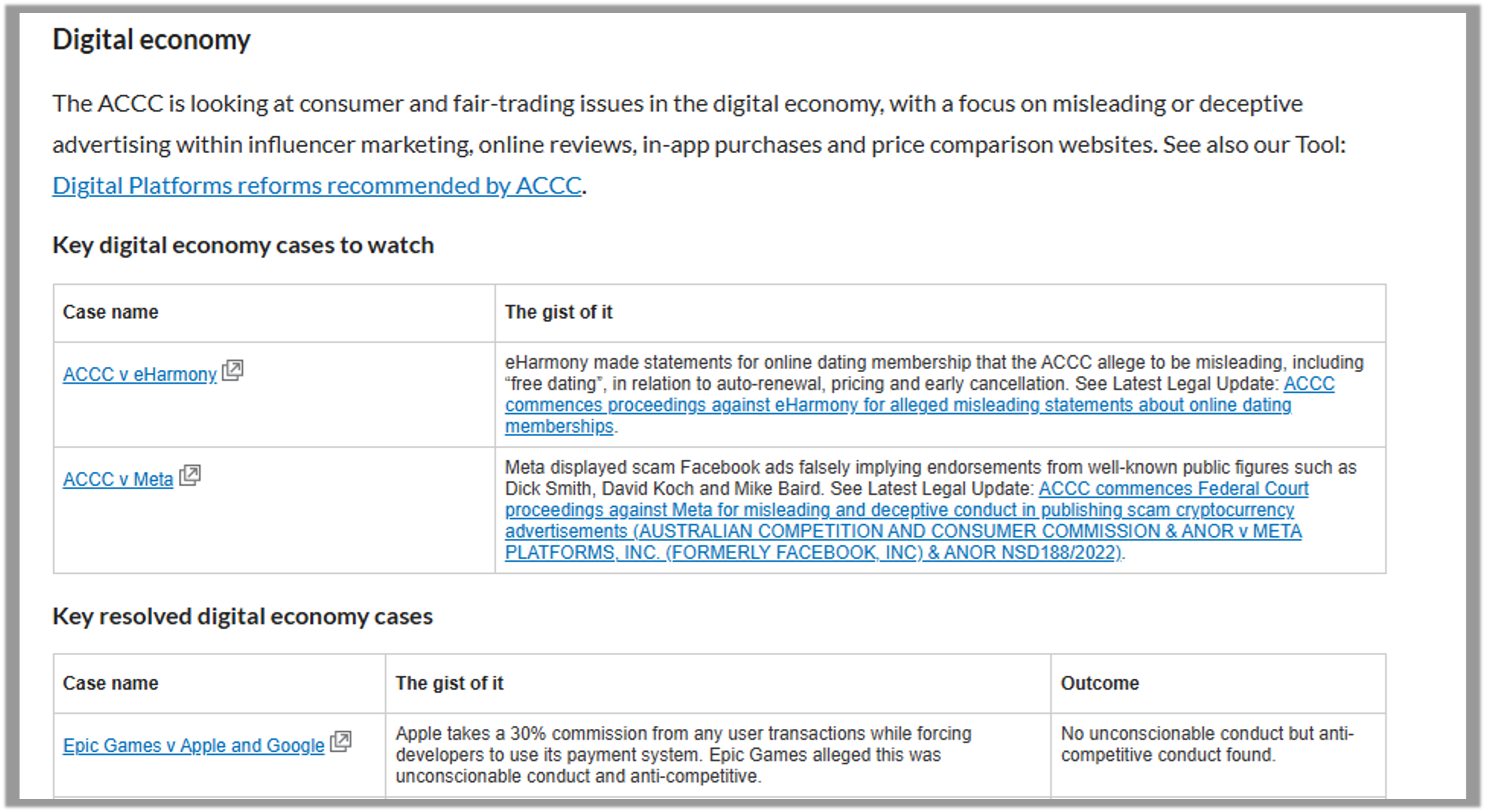
New | Checklist of Steps for Boards to Ensure Effective AI Governance
A practical checklist for boards to identify what steps they need to take with respect to the use of AI systems in their business, including the development of an AI strategy and a robust AI governance framework.
New | Financial Services Horizon Scanner
A quick-reference resource compiling upcoming legislative, regulatory, and other relevant developments and reforms in the financial services space.
Coming Soon | Infographic ASIC Enforcement Priorities 2026
Handy one-page tool summarising the regulator’s priorities for the upcoming year and highlighting tips and key takeaways for practitioners.
Coming Soon | Precedent AGM Minutes
This precedent set of annual general meeting (AGM) minutes can be used by listed and non-listed entities to ensure that the AGM runs as smoothly as possible. The precedent AGM minutes contain links to additional Practical Guidance Corporations guidance on how to comply with AGM meeting requirements.
Coming Soon | Checklist for Boards on Nature and Biodiversity Reporting
This checklist assists boards in preparing for the nature and biodiversity reporting regime (currently voluntary under the Taskforce on Nature-related Financial Disclosures (TNFD)) as part of discharging their directors’ duties within their corporate governance framework.
Coming Soon | New Guidance: Tort for Serious Invasion of Privacy
New guidance on the statutory tort for serious invasion of privacy. The statutory tort establishes a cause of action for any person who has suffered a “serious invasion of privacy”. This guidance note will consider the new statutory tort, including an analysis of how the courts are likely to interpret key provisions.
New | Topic: Australian Capital Territory – Magistrates Court
New topic comprising 14 subtopics that address practice and procedure in the Magistrates Court of the Australian Capital Territory, including the preparation of originating process, service, discovery, evidence, applications, costs, and appeals.
Coming Soon | Topic: Administrative Review Tribunal (Cth)
New topic addressing practice and procedure in the Administrative Review Tribunal, which replaced the Administrative Appeals Tribunal when it commenced operations in October 2024.
New | Precedents: Parental Leave
New precedents for employers responding to requests for extension of unpaid parental leave beyond the available parental leave period.
Coming Soon | Topic: Workplace Investigations
New topic providing guidance on practical considerations and principles relating to workplace investigations from receipt of grievance to finalisation of investigation.
Coming Soon | Enhanced Topic: ESG
New and updated content in an enhanced topic on ESG covering detailed guidance on environmental reporting and climate reporting.
New | Court Applications Guidance
From applications by a company under restructuring to adjourn pending winding up application, to applications for security for costs against companies in external administration and applications for directions, these new guidance notes add to our ever-increasing content on insolvency & restructuring court applications.
New | Guidance Notes for Court Applications to Relieve Administrators from Liability for Rent and New Funding
In large voluntary administrations, often urgent applications at the beginning of the administration are required. These guidance notes contain practical step-by-step guides, including outlines of draft affidavits.
Updated | Insolvency Law Training Tool – Insolvency Fundamentals for Creditors
Use these training materials (comprising slides and accompanying speaker notes) for your internal or external presentations.
Coming Soon | New Precedents for an Application for Release of a Liquidator and Deregistration and Supporting Affidavit
These precedents will assist practitioners in getting a head start on preparing these applications.
Updated | Indigenous Cultural IP
Following the updates to the First Nations fashion collaboration and international ICIP protection and ICIP case studies guidance notes, and the Checklist for Indigenous Cultural Intellectual Property Rights (ICIP) earlier this year, the remaining topics have been updated. With more developments expected in this area, there will be further updates to this topic by the end of the year.
New | Copyright Policies
New precedent, checklist, and guidance on copyright policies. Clear guidance on drafting and reviewing copyright policies, to supplement and support the precedent and checklist. The precedent paves the way for more efficient practice, and the checklist is designed to simplify the process and ensure that critical points are not missed.
Practice Area Highlight | Australian Trade Marks Office Decisions Tracker
The Australian Trade Marks Office decisions tracker is a succinct and informative guide to the main issues and reasons for the outcome of proceedings before the Trade Marks Registry, saving customers hours of time in trawling through the 20-odd decisions published per month. Cases are listed in reverse chronological order, so the most recent case is at the top. Links to relevant guidance are at the top of the tracker, as well as “Jump to” links to decisions for previous years.
New | Scheme Implementation Deed
New Scheme Implementation Deed for the acquisition of a company pursuant to a court-approved scheme of arrangement.
Updated | Guidance Notes: Competition
Updated guidance notes on the new merger reforms.
Updated | Guidance Notes: Schemes of Arrangement
Updated guidance notes on court-approved schemes of arrangement under Part 5.1 of the Corporations Act.
Updated | Guidance Notes: Takeovers
Updated guidance notes on off-market takeovers under the Corporations Act.
New | Guidance Notes: Institutional Abuse
New guidance notes in the institutional abuse topic discuss evidentiary considerations when bringing an abuse claim, permanent stays, and common law procedure.
Updated | Guidance Notes: Institutional Abuse
Updated guidance notes expand upon the Royal Commissions findings and recommendations, setting aside previous settlements by applying the “just and reasonable” test and establishing child abuse claims.
Updated | Checklist for Initiating an Abuse Claim
The new checklist lists necessary components for making an abuse claim, including salient details to be obtained from the plaintiff and relevant evidence to be gathered.
Coming Soon | New Precedents for Claimants and Respondents Disclosing Evidence in Motor Vehicle Accident (CTP), Common Law Workers’ Compensation, and PIPA Claims
These precedents will assist plaintiff and defendant practitioners in disclosing evidence during these types of personal injury claims.
New | Improved Coverage of the National Disability Insurance Scheme
LexisNexis’ caselaw coverage includes decisions of the Administrative Review Tribunal of Australia. This Tribunal is the first level of review for decisions relating to the National Disability Insurance Scheme (NDIS). Practical Guidance Personal Injury Victoria is now adding depth to its NDIS guidance by incorporating key parts of this body of law.
Coming Soon | Total and Permanent Disablement Claims
New guidance notes are being prepared by a leading superannuation law expert relating to Income Protection Insurers' contractual and equitable rights of recovery, and also the impact of TPD lump sums on WorkCover weekly payments.
Updated | Sales and Purchases Contract Preparation and Vendor Disclosure Subtopics
New and updated content in the sales and purchases topic, focusing on the preparation of contracts of sale and vendor disclosure obligations. Updated materials include expanded guidance on purchaser due diligence, off-the-plan contracts, and consequences for disclosure failures. New precedents include heads of agreement, deed of guarantee, requests for information for commercial properties, and contract special conditions.
Updated | Property Law Act 2023 (QLD) Content
Module-wide content updates to reflect the changes introduced by the Property Law Act 2023 (QLD), which took effect from 1 August 2025.




